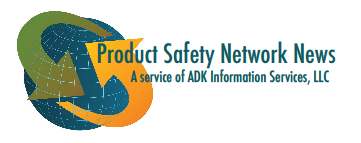CPSC: Urges July 4th safety after 8 fireworks-related deaths and nearly 13,000 injuries in 2017
June 27, 2018, cpsc.gov
At a fireworks safety press conference and demonstration on the National Mall, the Consumer Product Safety Commission announced that eight fireworks-related deaths were reported in 2017, with victims ranging in age from four to 57. There were an estimated 12,900 fireworks-related, emergency department-treated injuries in 2017. Moreover, about 67 percent of the estimated annual fireworks-related, emergency department-treated injuries for 2017 occurred during the month surrounding the Fourth of July holiday, between June 16, 2017 and July 16, 2017. During this one-month period, sparklers were the number one cause of injuries, accounting for 14 percent of the estimated injuries.
Toys R Us is closing. ‘There is nothing left’: The day it closed for good
June 30, 2018, New York Times
Toys ‘R’ Us, a brand that dates to 1957, closed the last of its 735 stores across the country this week. As more Americans shop online, the company’s cavernous suburban stores became outdated and the $5 billion debt from its private equity owners too onerous.
Why civility in politics won’t be getting any better
June 30, 2018, The Hill
It really is true that there’s been a decline in political civility in recent years. Some say it started with Robert Bork’s 1987 Supreme Court confirmation battle. Whenever it started, we seem to have a hit an all-time low. The 1960s saw the creation of the Equal Employment and Opportunity Commission and the National Transportation Safety Board. In the 1970s, there was the Environmental Protection Agency, Consumer Product Safety Commission, Federal Election Commission, Occupational Safety and Health Administration, Nuclear Regulatory Commission, and U.S. Commodity Futures Trading Commission. Each of these organizations created a host of new, often controversial regulations that fall under the jurisdiction of federal courts. Existing agencies were also granted new regulatory powers.
White Paper: Consumer product safety in an IoT world
June, 2018, Society of Product Safety Professionals (Tim Cassidy with Eric Xu)
A Society member helps to launch a new White Paper section at SPSP’s web site. He offers insight into some of the product safety aspects of the IoT (Internet of Things). The emerging and ubiquitous nature of the IoT may present hazards that traditional physical safety validation methods are ineffective in mitigating. This paper is intended to explore these potential vulnerabilities and consider options of risk mitigation.
California seeks to clear coffee of cancer risk warnings despite presence of dangerous chemical
June 18, 2018, Kaiser Health News
If approved, the proposed regulation could be a win for the coffee industry, which lost an 8-year-old lawsuit in the Los Angeles Superior Court over a law that could require warnings be placed on all packaged coffee sold in the state. California officials, having concluded coffee drinking is not a risky pastime, are proposing a regulation that will essentially tell consumers of America’s favorite beverage they can drink up without fear. The unprecedented action was taken by the Office of Environmental Health Hazard Assessment.
Massachusetts: Senate Passes Bill To Ban Toxic Flame Retardants
June 21, 2018, Patch.com/Beacon Hill
The Massachusetts Senate voted unanimously on June 21 to ban 11 toxic flame retardants from children’s products, bedding and residential upholstered furniture sold or manufactured in the Commonwealth. Public health advocates hailed the vote as an important legislative victory and called upon the House to pass the bill before the end of the Massachusetts Legislative session.
Can Washington Create Smarter Regulations?
June 15, 2018, Knowledge @ Wharton
The number of U.S. regulations has grown exponentially in the last few decades, often creating a quagmire of confusion for those charged with drafting and implementing these rules. But it is possible to achieve what University of Pennsylvania law and political science professor Cary Coglianese calls regulatory excellence. Coglianese, who heads the Penn Program on Regulation, spoke recently to staffers on Capitol Hill as part of a Penn Wharton Public Policy Initiative series about how to build a framework for sensible, flexible regulation no matter which party is in the White House.
New High Chair Safety Standards Are Coming — Here’s Everything You Need to Know
June 21, 2018, Good Housekeeping
After more than 18,000 high chair-related emergency visits from 2015 through 2016, the United States Consumer Product Safety Commission (CSPC) has announced an updated standard of safety for chairs used both at home and in restaurants. As a parent, navigating these changes can be a little tricky, so the Good Housekeeping Institute tapped its experts to get the answers to all burning questions about the new safety measures.
Gas alarms could kill: Carbon monoxide detectors sold on Amazon and eBay fail safety tests
June 21, 2018, Daily Mail (UK)
Dozens of carbon monoxide alarms sold via Amazon and eBay have been removed from sale after an investigation found they failed safety tests. Four alarms bought from the two retail sites and tested by Which? failed to sound when the gas was present in the air, making them potentially lethal in the event of a carbon monoxide build-up in the home.All four alarms claimed to meet the British safety standard for detecting carbon monoxide.
What to do after a child swallows a button battery? Try honey, CHOP study suggests
June 18, 2018, Herald Online
A team of pediatric ear, nose and throat specialists from Children’s Hospital of Philadelphia and Nationwide Children’s Hospital has discovered that giving a child honey to eat after he or she has swallowed a small battery can prevent serious injury and possibly even death. “Since serious damage can occur within two hours of ingesting a battery, the interval between ingestion and removal is a critical time to act in order to reduce esophageal injury,” said Jacobs, whose team’s findings were published in the journal The Laryngoscope.


